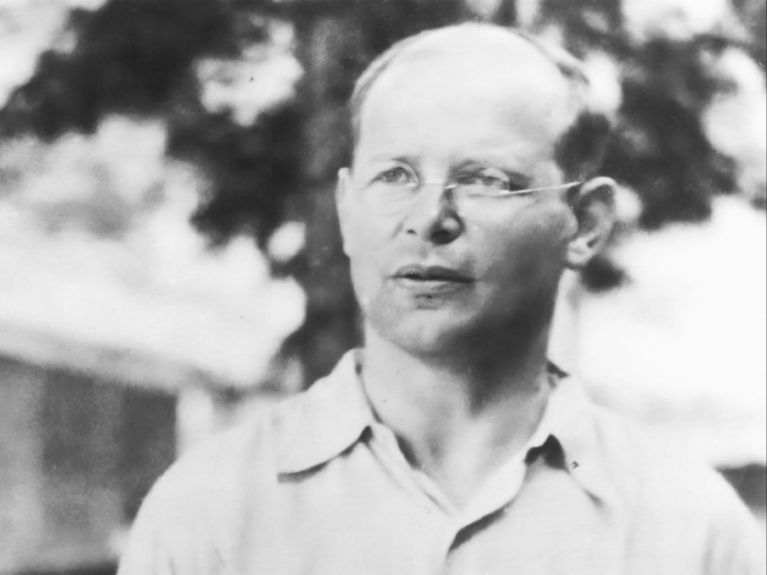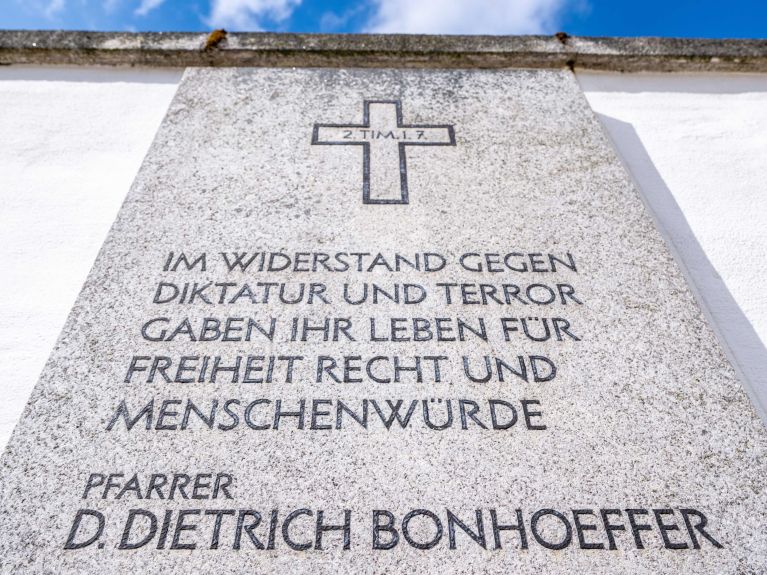Dietrich Bonhoeffer: faith in contradiction
It is not possible to be a National Socialist and a Christian at the same time: this is the attitude that defined the life of Dietrich Bonhoeffer. The theologian was murdered by the Nazis on 9 April 1945.

Dietrich Bonhoeffer, a theologian and resistance fighter, is now one of the most important figures of the 20th century and stands above all for politically engaged Christianity. Born in Breslau (now the Polish city of Wroclaw) on 4 February 1906, he grew up with seven siblings in an upper middle class family. His father Karl Bonhoeffer, a psychiatry professor, was appointed to a chair at Berlin’s Charité hospital in 1912 and the family moved to a villa in the city’s affluent Grunewald neighbourhood. The Bonhoeffers didn’t have much to do with the Church, so they were surprised when their youngest son Dietrich decided after leaving school to study Protestant theology. In accordance with the family’s expectations, he aspired to an academic career. He completed his PhD at the age of 21 and by 24 was the youngest lecturer at the theological faculty. Later he regretted his excessive ambition and believed that he had become a good theologian but not a Christian. This change in mindset came about partly because he spent a year at the Union Theological Seminary in New York. He learnt there how a Christian can contribute to resolving social problems such as poverty and injustice.
If necessary, drive a stick into the spokes of the wheel itself.
When the Nazis seized power, Bonhoeffer warned early on of the dangers posed by the new regime and the cult of the Führer. He could not sign up to the widespread view that the Church should not intervene in politics. In his view, the anti-Jewish laws of the Nazis, such as the “Aryan paragraph”, were not compatible with the Bible’s idea of what it means to be human. And he refused to recognise the Church of the Reich with its Bishop of the Reich Ludwig Müller, which were installed by the Nazi regime. He believed that it was not possible to be a National Socialist and a Christian at the same time. When in a speech to Berlin priests he demanded that the Church should if necessary “drive a stick into the spokes of the wheel itself”, i.e. to engage in political resistance, many left the room.
Dieses YouTube-Video kann in einem neuen Tab abgespielt werden
YouTube öffnenThird party content
We use YouTube to embed content that may collect data about your activity. Please review the details and accept the service to see this content.
Open consent formInvolvement in establishing the Confessing Church
Bonhoeffer played a key role in establishing a counter-church known as the Confessing Church, though he criticised the fact that it did not take a more resolute stance in its declarations against the “Aryan paragraph” and Hitler’s aspiration to total power. In his view, believing that the Church could maintain its independence within a totalitarian system was a dangerous illusion. When he demanded that all regime-critical priests should go on strike, he also became sidelined in the Confessing Church. To obtain some distance, he became the pastor of two churches in London. While there, he received a request from the Confessing Church to return to Germany and to take over as head of a seminary for preachers. Such seminaries were intended to prepare future priests for their duties. They were considered the “centres of power” of a counter-church. Bonhoeffer accepted this role. His teachings involved a mixture of spiritual education, theological knowledge and political enlightenment.
Swift return from New York
Gradually, further laws and decrees pulled the rug out from under the seminaries, with the ultimate result that they could only survive underground. Bonhoeffer himself increasingly attracted the Gestapo’s attention. He was banned from teaching or giving speeches in public. Fearing he would soon be arrested, his friends urged him to move to the USA. Bonhoeffer did so, but reluctantly. After just a few weeks, he returned from New York to Nazi Germany in July 1939. He felt that he would have no right to participate in the reconstruction of Germany if he did not share the plight of the people in Germany.
He learnt of the plans to assassinate Hitler from his brother-in-law Hans von Dohnanyi and joined the resistance group led by Major-General Hans Oster. He was supposed to use his contacts abroad to ascertain how politicians - in England in particular - would react if Hitler were ousted and the regime successfully overthrown. During this time Bonhoeffer got to know 18-year-old Maria von Wedemeyer. The couple became secretly engaged. On 5 April 1943, however, Bonhoeffer was arrested and taken to the prison in Berlin’s Tegel district. As there was scant evidence against him, it was hoped that he might be released again. Following the failed assassination attempt on Hitler by the group led by Claus Schenk Graf von Stauffenberg, his involvement in the plans to overthrow the regime were uncovered.
Death at Flossenbürg concentration camp
Following heavy aerial bombardment of Berlin, Bonhoeffer was initially transferred to the basement of the Gestapo prison in Prinz-Albrecht-Strasse and then taken to Buchenwald concentration camp. With Germany close to falling, he spent a short time there before being transported with other prisoners all across southern Germany, the group eventually being housed provisionally in a school building in the village of Schönberg in the Bavarian Forest. The next morning he was picked up and taken to Flossenbürg concentration camp. He was interrogated overnight, a drumhead court-martial sentenced him to death and at dawn on 9 April 1945 he was executed.

His family and his fiancée Maria von Wedemeyer did not learn of Dietrich Bonhoeffer’s death until the end of July. It turned out that his brother Klaus and his brothers-in-law Hans von Dohnanyi and Rüdiger Schleicher were also shot and hanged respectively. More recently, religious and political right-wing groups have attempted to appropriate Bonhoeffer for their own ends. A look at his life and his writings makes it quite clear that any such attempts at reinterpretation are a perversion of everything the theologian lived and fought for.
Alois Prinz
published a biography of Dietrich Bonhoeffer in 2020: “Dietrich Bonhoeffer. Sei frei und handle!“ (Be Free and Act!).



